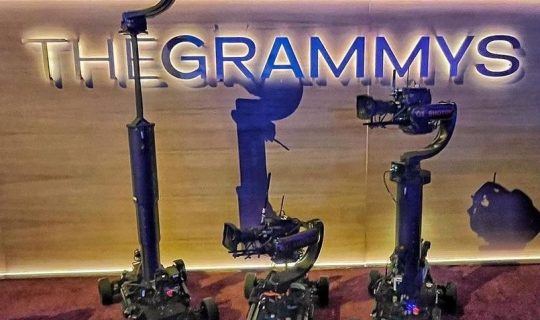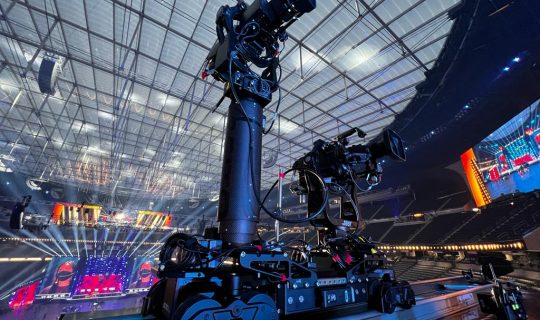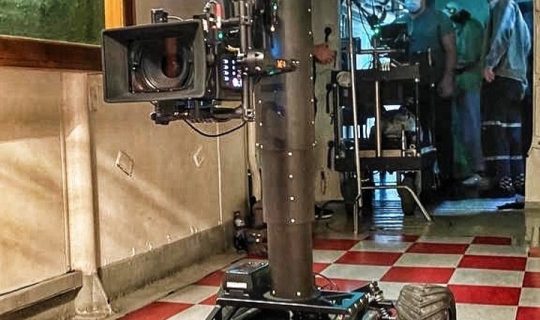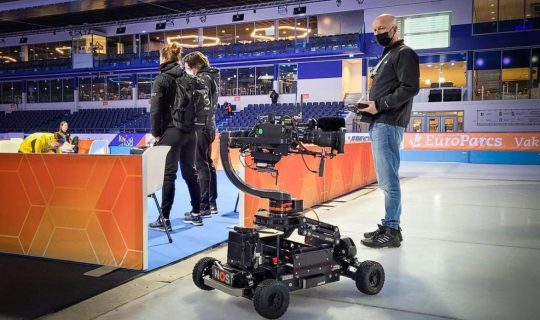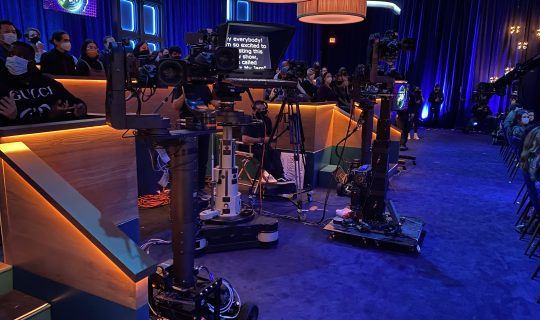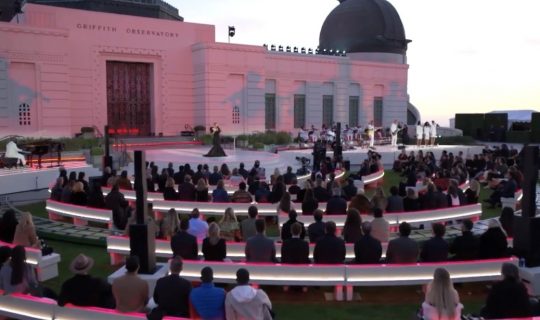Football’s best new signing? AGITO

For all the evolution of football itself – VAR overturning last minute injustices, data analytics dictating tactics, augmented reality dressing up half-time analysis – one thing has remained surprisingly unchanged: the way the game is filmed.
For decades, the broadcast formula has been practically untouchable. Fixed cameras offer the all-important wide shots. Steadicams patrol the sidelines, offering intimacy. Cranes sweep across the stands for scale and spectacle. And Spidercams glide dramatically above it all, adding that first layer of immersive motion into the mix. Each plays its part, and together they form the foundation of contemporary sports broadcasting.
But even the best ensemble can benefit from a new perspective.
Designed and built by Motion Impossible, AGITO is a modular, remote controlled camera dolly that moves fluidly at ground level – bringing a dynamic energy to matchday moments that were previously difficult to film. It doesn’t replace traditional tools; it compliments them. Think of it as a Spidercam on the ground, keeping up with the play for dramatic effect, but with fewer cables and more agility.
And nowhere has it been embraced more than in Saudi Arabia, a country that has already made it part of the broadcast playbook.
Why Saudi Arabia is driving football innovation
While European leagues tend to guard tradition like a priceless heirloom, Saudi Arabia sees football broadcasting as an opportunity. The country has become a testing ground for new technology, using major tournaments like the Italian Super Cup and the CAF Champion’s League as a platform to push production boundaries.
“In the Italian domestic league, they don’t have much freedom to try new things,” explains Asier Diaz, head of Alamiya’s special cameras department. “But when they came here to Saudi for the Super Cup, they were actively looking to try something different.”
That mindset is a stark contrast to the caution often seen in Europe, where the prevailing attitude is “if it’s not broken, don’t fix it” – even when something clearly could be improved. Saudi Arabia, by contrast, actively encourages innovation. “They’re not afraid to experiment,” explains Asier.
It’s this appetite for progress that has given Alamiya – the production company responsible for filming these tournaments – the chance to introduce AGITO into mainstream football coverage. And the results have been striking/
Meet the man behind the tech – Asier’s role at Alamiya
Asier has been at the forefront of bringing AGITO to football broadcasts in Saudi. He manages Alamiya’s special cameras department, which houses Skycam, cinematic style cameras and drones – but AGITO has always been one of his most exciting projects.
“When we created the department three years ago, AGITO was one of the first systems we brought in,” he says. “At the time, it was one of the most advanced systems we were running, so I took it on personally.”
For the first one or two years, Asier operated AGITO himself, ensuring it was deployed effectively in live sports coverage. Now, it’s fully embedded in Alamiya’s workflow, with multiple technicians trained to use it. But even though he doesn’t need to, Asier still takes the controls for major matches – not out of obligation, but because it’s “fun”.

How AGITO captures football differently
Behind-the-goal shots – reacting in real-time
Football is full of blink-and-you’ll-miss-it moments – penalty shootouts, free kicks and last-minute goal attempts. Typically, behind-the-goal cameras are static, meaning directors must commit to a single viewpoint before the match even begins.
AGITO removes that restriction entirely. “You just need to press a button, and it’s there in a matter of seconds,” explains Asier. “Instead of relying on a fixed position, it can shift on demand, reaching speeds of 27mph (43.4km/h) to track the ball’s movement, capture the goalkeeper’s reactions or follow the immediate aftermath of a match-winning goal. It’s a more responsive way of filming football – one that ensures every crucial moment is seen from the best possible angle.”
Pre-match warm-ups – moving inside the pitch
Most pre-match coverage consists of wide shots of players jogging and stretching, captured from a safe distance.
AGITO allows for something far more immersive by moving inside the pitch itself, weaving between players and capturing the intensity of their pre-game rituals up-close. “During warm-ups, we’re actually inside the pitch,” explains Asier. “We move between the players, getting the cinematic shots that directors love because we can stay on them.”
Instead of treating warm-ups as a minor prelude, AGITO lets fans experience the atmosphere, focus and last-minute preparations as if they were on the grass themselves.
The player walkout – a more cinematic opening
The walkout is a moment in football that often goes underappreciated – that quiet, charged transition from tunnel to pitch. For years, broadcasters have covered it well enough, cutting between different cameras to piece together the journey – a close-up of the captain, a cutaway to fans waving scarves. But it never quite captures the full experience.
Instead of jumping between angles, AGITO follows the players in one seamless motion. “Some players like to go from the bus straight to the pitch,” says Asier. “They go to the centre, look around, feel something magical – and we use AGITO to capture all of that.”
Trophy celebrations – following the chaos
The post-match trophy lift is another moment that traditional cameras struggle with. Players are running in every direction, staff and photographers flood the pitch and Steadicam operators – already exhausted – have to sprint through the chaos to get a clean shot.
“For the trophy ceremony, the Steadicam operators are already very tired,” Asier explains. “AGITO gives you a chance to keep working another half an hour after the match, just by changing batteries.”
Rather than relying on stationary cameras or handhelds dodging flying bottles of champagne, AGITO allows for long, uninterrupted shots that make the celebration feel more cinematic.

Technical considerations
AGITO might look like it’s gliding through a match as though choreographed, but its use in live sports comes with the same non-negotiable priorities as any other system: safety and reliability.
Let’s start with control. Yes, a skilled driver is essential – someone with spatial awareness and match sense. But AGITO isn’t just a free-roaming rover. It’s packed with features that keep it safe to operate: speed limits, collision-detection and a magnetic-guided (MagTrax) or track-based (Trax) mode that allows pre-defined movement paths for tightly controlled deployment.
And then there’s radio frequency stability. In a stadium – where signals fly in every direction like confetti – AGITO stands out for its ability to operate licensed bands. “Frequencies are the key point in my opinion,” says Asier. “If you lose connection, that’s a big problem – especially if AGITO is in the middle of the pitch when the match is about to start.” That’s why using dedicated, interference-resistant RF bands is critical. “AGITO has proven it can hold up in some of the busiest, noisiest broadcast environments out there.”
The future of football broadcasting
And so, the future of broadcasting isn’t about wheeling off traditional equipment into early retirement. Steadicams, cranes, Spidercams and static cams still have their place – and an important one at that. But football coverage is evolving, and the leagues that embrace new tools like AGITO will shape the future. It’s not about replacing what works; it’s about expanding what’s possible in sports coverage.
Asier has already seen the shift firsthand, once it’s in play, people start to take notice. “In the Italian Super Cup, even the replay operators started pointing their attention to it,” he recalls. “They saw it was giving very nice replays, tracking the action in a way that no other system could.”
And it’s not just the production teams noticing. Players interact with AGITO differently, often creating spontaneous, human moments that add to the broadcast. “Sometimes, players are really surprised when they see AGITO,” says Asier. “They pass the ball to the camera, make jokes, smile – it’s great for live coverage.”
And this is where Saudi Arabia is setting the pace. While European leagues cautiously consider their next move, Saudi has already done it. With Alamiya at the helm, they’re not waiting to see if the future works – they’re already using it.
So, here’s the real question: with football coverage evolving fast, will broadcasters for other leagues lead the charge – or be left watching from the sidelines?

AGITO offers multiple configurations to suit your filming needs, it’s a swiss army knife for film-makers. Perfect for use in the studio or on location, AGITO Sports offers a new way of moving a camera, with complete flexibility using our growing arsenal of modules and accessories, and an ease of operation not available with any other system.
DISCOVER MORE
























